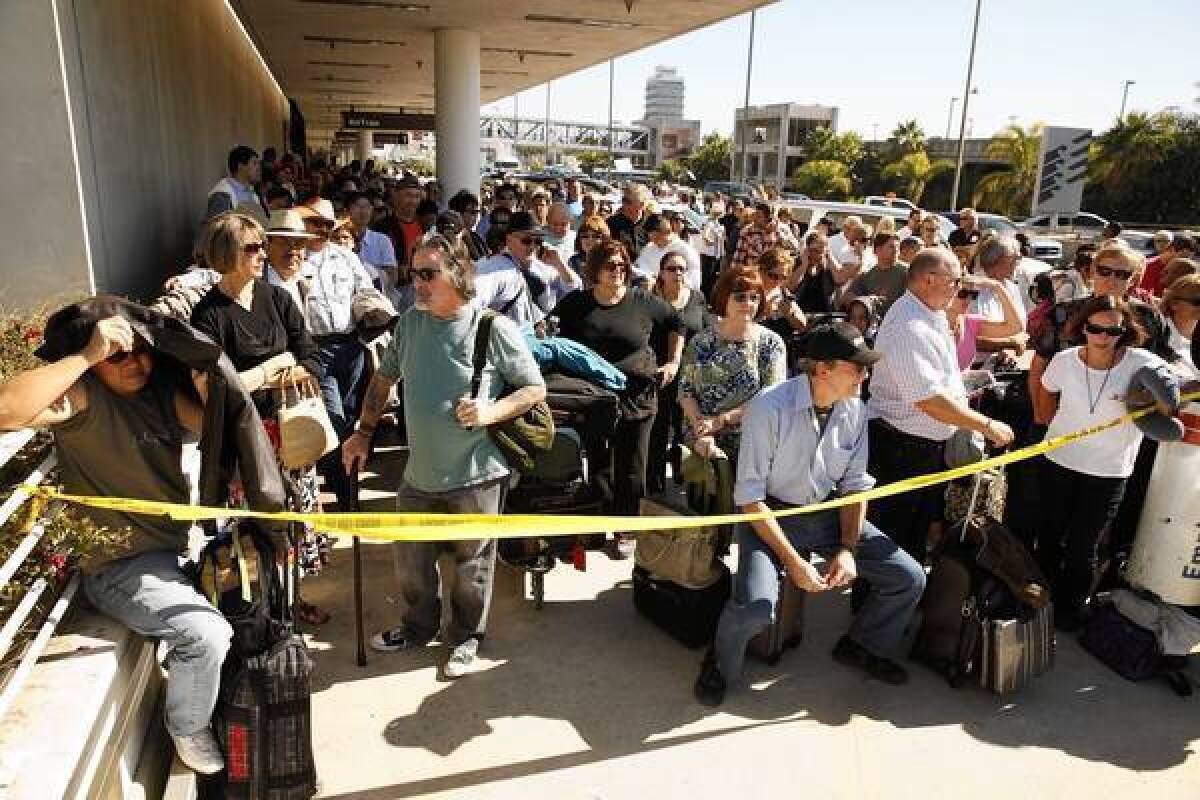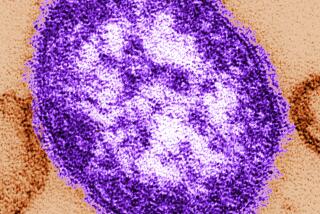Deadly rampage creates chaos at LAX

- Share via
A composed, solitary gunman shot his way into Los Angeles International Airport on Friday morning, killing a transit security screener and injuring at least one more before being wounded by police and taken into custody. The incident was over in less than 10 minutes but caused chaos at the world’s sixth-busiest airport and disrupted thousands of flights across the nation.
The suspected gunman was identified as Paul Anthony Ciancia, 23, a New Jersey native who lives in Los Angeles.
Authorities declined to discuss the gunman’s motivation publicly. But a law enforcement official told The Times that a note was found on the gunman expressing “disappointment in the government” and noting that he had no interest in hurting “innocent people.” Ciancia also sent a sibling a text message last week suggesting that he was prepared to die, officials said.
It appears the gunman targeted Transportation Security Administration agents, who are not armed. Authorities said he approached several people cowering in the airport terminal, pointed his gun at them, asked if they “were TSA” and then moved on without pulling the trigger if the answer was no. A witness said the gunman cursed the TSA repeatedly as he moved through the terminal.
J. David Cox Sr., president of the union that represents 45,000 TSA flight screeners, called the shooting a “heinous act.” The gunman was not a TSA officer and “never had been,” according to the union, the American Federation of Government Employees.
The TSA was created in the aftermath of the 9/11 terrorist attacks in an attempt to improve the safety of American transportation. Its screeners cannot make arrests and do not carry weapons.
A former classmate of Ciancia’s said Friday the suspected gunman was a loner and had been bullied at their private high school.
“In four years, I never heard a word out of his mouth,” said David Hamilton, who graduated with Ciancia from Salesianum School in Wilmington, Del., in 2008 and is now an editorial assistant at a publishing firm in Philadelphia. “He kept to himself and ate lunch alone a lot. I really don’t remember any one person who was close to him.”
Officials did not immediately identify the 40-year-old screener who died — the first TSA officer killed in the line of duty. In all, seven people were injured. Six were taken to area hospitals. It remained unclear if the gunman and the slain TSA officer were included in that total. All of those injured were adults, hospital officials said. Some were not shot but suffered what authorities called “evasion injuries,” sustained as they attempted to run.
At 9:20 a.m., the gunman entered the third of LAX’s nine terminals through the main door, pulled an AR-15 assault rifle out of a bag and “began to open fire,” said Los Angeles World Airports Police Chief Patrick Gannon.
The gunman walked up one flight of stairs, to the entrance of the security checkpoint, where, officials said, he shot at least one of the TSA officers. He then entered the airport itself, walking with determination past a candy shop, a newsstand and a bookstore. An airport police officer and a sergeant engaged the gunman in a brief gunfight near a food court.
“They hit him multiple times before he went down,” said one law enforcement source. A witness said the gunman was wearing a bulletproof vest.
As the gunfire echoed through the terminal, panic erupted and screams ricocheted down the corridors.
Travelers and employees crawled on the floor and ducked behind planters and advertising kiosks. Passengers tripped over one another and abandoned baggage as they barreled backward through the security check.
Jonathan Paul, 36, of Santa Monica looked up from a newsstand and saw a wave of terrified people racing toward the main entrance. He said some were shouting “Go! Go! Go!” Some travelers were halfway through security when the shooting erupted and raced for the doors with their shoes and belts in hand.
Others, guided by no one and unsure where to go, pushed open emergency exit doors and fled the terminal. Some raced across tarmacs and some attempted to seek shelter on planes that were still taxiing.
Brian Adamick, 43, who was preparing to board a Spirit Airlines flight for Chicago for his brother’s wedding, was among those who escaped the terminal by running onto the tarmac. Before long, buses arrived to evacuate passengers. A wounded TSA officer with a bloody ankle boarded one of them.
“I got shot,” the officer told Adamick. “I’m fine.”
Stephanie Rosemeyer, 26, was awaiting a flight to Chicago when she saw people running toward the exits. She stood up in search of the source of the commotion, she said, and found herself looking directly into the gunman’s eyes. She took a step and heard the gunman curse the TSA. She was among those who raced onto the tarmac and was evacuated by bus.
“There was no one directing anything,” she said.
Vernon Cardenas, 45, was one of the last people still inside Terminal 3 and was trying to determine whether he’d be safer running or staying when he found himself face to face with the gunman. The gunman, dressed in dark clothing and no longer carrying a bag, had his weapon pointed to the ground and stared directly into Cardenas’ face.
“He wasn’t moving like he was being chased,” said Cardenas, the executive chef at State Social House restaurant in West Hollywood, who was preparing to fly on Virgin America to Philadelphia to conduct auditions for the television show “MasterChef.”
Rather, Cardenas said, the gunman was moving slowly and methodically; Cardenas said he instantly thought of the grainy surveillance footage of the teen shooters moving through Columbine High School in 1999 — “roaming around with nowhere to go.”
Cardenas ducked outside, through an emergency exit, and remained there until a law enforcement official gave him a thumbs-up through the window, indicating that it was safe to go back inside.
Outside the airport, a surreal scene unfolded, as travelers hurried with rolling bags and strollers past a sea of ambulances and a phalanx of heavily armed law enforcement officials.
The ripple effects of the shooting will last for days on global travelers. Three terminals were evacuated and shut down. Flights were restricted into LAX for six hours. At least 118 flights en route to LAX were canceled or rerouted; 135 departing flights were canceled and 127 departing flights were delayed at least 15 minutes. Several planes full of passengers spent hours parked at a remote corner of the airport.
Gina Marie Lindsey, executive director of Los Angeles World Airports, which operates LAX, said getting operations back to normal would require a “carefully orchestrated logistical ballet.” Los Angeles Mayor Eric Garcetti called LAX “a very difficult place to come to and travel to.”
Six hours after the shooting, passengers were still wandering the streets surrounding the airports, emerging from various sidewalks and roadways as they looked for a way out. Many rolled bags; a few pushed carts full of luggage. Others had small dogs or children with them.
People begged anyone in a uniform for information about whether terminals were open or where they could go. A crowd flooded the intersection of Century and Sepulveda boulevards, as police provided occasional updates on loudspeakers. While waiting to cross the street, a man jokingly shouted to an officer: “Can you get us a taxi?”
The officer laughed: “If you find one, let me know.”
Passengers hoping to catch Friday afternoon flights from LAX tried something Angelenos rarely do: They walked to the airport. With nearby roads and freeways blockaded, pedestrians walked across Imperial Highway, some nervously checking over their shoulders for nonexistent cars.
Stephen Hartley, 59, of Chicago had flown into Los Angeles to be with his daughter after her emergency appendectomy.
“I’m just going to walk until they say I can’t,” he said, before striding into the street.
Passengers walked across the exit ramps from the 105 Freeway and headed into the eerily quiet Sepulveda Boulevard tunnel. The only sounds were the echo of footsteps and the clack of rolling suitcases on the pavement.
Francis Specker, 50, of Riverside, was supposed to take a 10:30 a.m. flight to New York out of Terminal 3. Specker was on the shuttle bus when the vehicle was told to turn around; he eventually walked to a nearby hotel and was hoping to catch a later flight.
Specker was living in New York during the 9/11 terrorist attacks and said Friday’s shooting was not a huge surprise.
“I guess this is sort of the new normal, right?”
Times staff writers Richard Winton, Brian Bennett, Scott Glover, Dan Weikel, Joseph Serna, Ari Bloomekatz, Samantha Schaefer, Hugo Martin, Matt Stevens, Jill Cowan and Laura J. Nelson contributed to this report.
More to Read
Sign up for Essential California
The most important California stories and recommendations in your inbox every morning.
You may occasionally receive promotional content from the Los Angeles Times.













